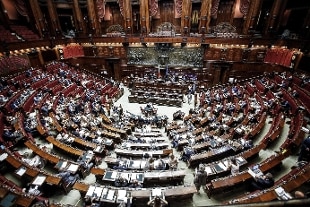Referendum on the cut of parliamentarians, third screening: Yes 68.1%, No 31.9%
Referendum cut parliamentarians.
Di Maio: historical result.
Molinari (Lega): dissolve the Chambers
Senate cancels resolution on annuities cut to former parliamentarians
Share
21 September 2020 From the current 945 to the future 600 MPs. A 'scissoring' of the overall elected representatives equal to 36.5% which, according to the detractors of the reform, would lead to a cost reduction of 0.007%. For the 5 stars, who have made the reform a workhorse, they would save about 500 million euros per term, or 100 million per year. The constitutional reform cuts 345 parliamentarians. Final approval came last October, with the go-ahead from the House. And with the birth of the Giallorossi government, it was also supported for the first time by Pd, Leu and Italia viva (despite the fact that in the three previous votes they had voted against). The opposition forces, Forza Italia, FdI and Lega also voted in favor. The clear victory of the Yes in the referendum confirms the reform. It will now take about two months to redesign the colleges.
The direct effect of the reform is the decrease in the number of deputies, which will go from 630 to 400 in total, and in senators, who will drop to 200 in total from the current 315.
Chamber
The total number of deputies, now 630, will be 400. The number of those elected abroad: from the current 12 to a maximum of 8. Following the constitutional amendment, the average number of inhabitants for each elected parliamentarian also changes. For the Chamber of Deputies, this ratio increases from 96.006 to 151.210. The distribution of seats among the constituencies, without prejudice to the number of seats assigned to the overseas constituency, is carried out by dividing the number of inhabitants of the Republic, as resulting from the last general population census, by 392 and distributing the seats in proportion to the population of each constituency, on the basis of integer quotients and the highest remainders.
Senate
The senators rose from the current 315 to a total of 200. The number of those elected abroad was also changed, from 6 to 4. The average number of inhabitants for each senator increased, in turn, from 188,424 to 302,420. At the moment, the Charter establishes that "no Region can have less than seven senators; Molise has two; Valle d'Aosta one". The reform identifies a minimum number of three senators per Region or Autonomous Province, leaving unchanged the current provision of Article 57, third paragraph of the Constitution, relating to the representatives of Molise (2 senators) and Valle d'Aosta (1 senator). However, for the first time, a minimum number of senatorial seats referring to the autonomous provinces of Trento and Bolzano is envisaged.
Senators for life
The reform also modifies Article 59 of the Constitution, expressly providing that the maximum number of senators for life cannot exceed 5. The amended article states: "The President of the Republic may appoint senators for life as citizens who have illustrated the homeland for its very high merits in the social, scientific, artistic and literary fields. The total number of senators in office appointed by the President of the Republic cannot in any case exceed five ".
Entry into force
The reduction of parliamentarians, the reform provides, takes effect from the date of the first dissolution or the first termination of the Chambers after the date of entry into force of the constitutional law and, in any case, not before sixty days have elapsed. The provision of the sixty-day deadline is aimed at "allowing the adoption of the legislative decree regarding the re-determination of the electoral colleges", which are currently divided as follows: for the Chamber of Deputies there are 232 single-member and 63 multi-member constituencies; 116 single-member and 33 multi-member colleges for the Senate.

